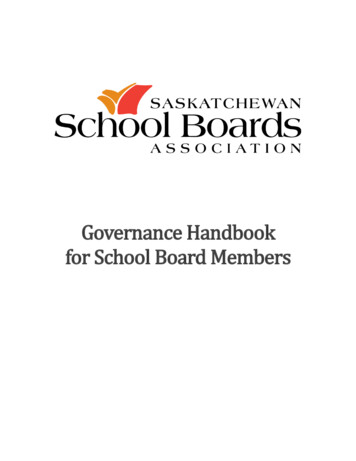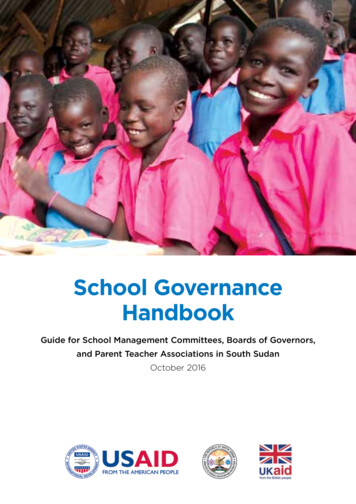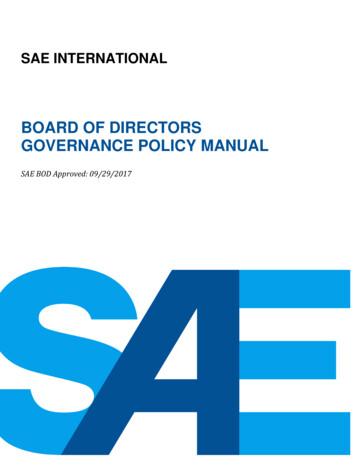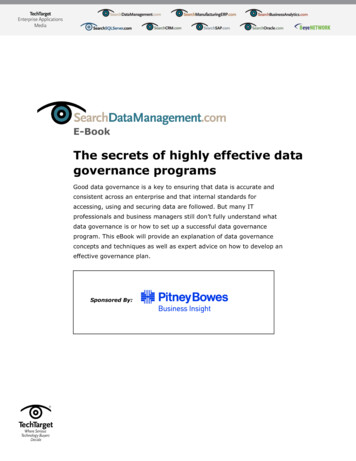
Transcription
Governance Handbookfor School Board Members
SUMMARY
What Board Members Need to Know about Governance and StrategyThe Education SystemAs a shared responsibility of both the Provincial and Federal governments, the sector is led inthe province by the Ministry of Education. In fulfilling its responsibility for the education ofyoung people, the Province has delegated local monitoring and guidance to School Boards.As of writing, there are 28 school divisions in the province. School divisions fall into threecategories: public, separate and francophone.Some Saskatchewan children receive their education outside of the publicly-funded K-12system. Services outside the publicly-funded system include First Nations Schools, IndependentSchools and Home-Schoolers.Educational organizations that represent various interests within the education system and playimportant roles in shaping educational policy and practice in Saskatchewan include: The Ministry of Education: responsible for Pre-Kindergarten to Grade 12 educationSaskatchewan School Boards Association: a voluntary, non-profit organization thatserves boards of education as the voice for publicly funded education in Saskatchewan.The Saskatchewan Association of School Business Officials (SASBO): a professionalassociation of certified school business officials.The League of Educational Administrators, Directors and Superintendents(LEADS): a professional association of educational administrators who work at the schooldivision levelSaskatchewan Teachers’ Federation (STF): a self-regulating, professional associationwhich provides numerous services to teachers, and a collective bargaining agent whichnegotiates collective agreement for teachers at the provincial levelThe Conceptual ModelYour primary job as a board trustee is not to manage theSchool Board, but to “govern” it. Governing meansdirecting and controlling – setting the strategic directionof the School Board (through the plan and budget), andthen being confident that the School Board is moving inthat direction (by monitoring and evaluating results).GOVERNANCE DEFINEDGovernance is the system by whichthe School Board is directed andcontrolled.Your legal duties are listed in The Education Act, 1995 (inshort): to administer and manage the educational affairs of the school division, and to exercisegeneral supervision and control over the schools – through bylaws and resolutions.In practice, the board of trustees governs (supervise and control) and the Director of Educationadministers and manages (delegated to and monitored by the board of trustees).Your key roles of the board in setting the strategic direction of the School Board are to:ooreview and approve the strategic plan;hire the Director of Education, delegate authority and manage this relationship; 2016 Saskatchewan School Boards Association - Education in Saskatchewan. All rights reserved.-2-
ooset the risk appetite and approve policies to guide staff; andreview and approve resourcing largely through the annual budget.School boards act on behalf of the citizens they represent and have authority over the schoolsystem and its resources. They usually do this by developing policies and monitoring outcomesto determine progress toward desired results and gaining assurance that the school board isheaded in the direction that was set. Your key roles:oooomonitor and report on the performance of the School Board;monitor and evaluate the performance of the Director of Education, and of the boarditself;oversee risk management, including compliance with policies; andreview and approve the financial reports and audit.Beyond your core governance (legal) roles of leadership and stewardship, School Boardmembers are expected to engage with key stakeholders, ensuring that the institution haseffective connections with all those who have a stake in the effective education and well-beingof children and youth.While the board focuses on these, the Director of Education and their staff perform the actualday-to-day work of providing a quality education to the young people of the region: there is a“bright line” between the responsibilities of each.Locally elected Boards of Education are an important part of the democratic process thatprovide a connection between the community and the education system. This connection helpslocal boards guide the direction of resources in a manner that will best suit the communitiesthey serve. They also provide a valuable outlet for parents to connect with the system in amore meaningful way.As a trustee you will be required to conduct yourself at all times in a professional manner andto fulfill your fiduciary duty as a board member. That means acting in the best interest of theBoard of Education, even when the needs of the board are in conflict with your own needs ordesires. This goes beyond simple conflict of interest where financial gain is at stake, but alsomeans you must put the needs of the board ahead of your own political aspirations.Both the Province and the School Board play roles in setting priorities for the education programand student achievement. The Ministry of Education may define key results and desiredstudent outcomes for the school system. They may also define school system cycles ofplanning, monitoring and reporting.What Board Members Need to Know About Governance and RiskIt is said that what gets measured gets done. Creating a strategic plan is just the first stage ofachieving results. A plan is merely an intention to act, real action must then take place, andyou need to have a way to be confident that these intentions are being realized. 2016 Saskatchewan School Boards Association - Education in Saskatchewan. All rights reserved.-3-
“Risk” deals with the uncertainty of achieving objectives – in the real world, no outcomes arecertain! The goal of risk management is to optimize risk, not to minimize risk. For instance, wecould eliminate all sports activities at schools to minimize the risk of sports injuries, but thatwould not serve our students well. Risk taking is the essence of how school boards exist,generate student outcomes and sustain themselves. Without risk taking there would be noinnovation, no progress and no advances in student outcomes.The Director of Education and staff managerisks by identifying, assessing, measuring,mitigating and monitoring them. Beyond this,you, the board, then have three roles in risk—risk direction, oversight and control.THE ROLE OF THE BOARD INRISK GOVERNANCEManagement reporting provides regularupdates for you to assess progress towardsobjectives, and whether this is within risktolerances.Risk Direction Setting risk tolerancesand appetite – range ofoutcomes for objectives How well are risks beingmanaged? What are weRisk OversightThe school board is responsible for ensuring alearning from actuals?safe and supportive environment for teachingand learning. Because the school board isaccountable when things go wrong, it just How effective aremakes sense that the board will take proactivecontrols? Are we “inRisk Controlcontrol”?steps to ensure that schools are safe places tolearn and work. School boards need to take abroad perspective. Issues range from airquality and bullying, to establishing a positive work environment, to retaining staff.The Saskatchewan School Boards Association offers numerous services that help school boardscreate safe and supportive environments in the schools of their division. These services includea comprehensive insurance program, legal services, an employee benefits program, and supportfor many aspects of employee relations.Engaging with the community is an important part of the school board’s job. All communitymembers have a need and a right to know what children are learning and how well they arelearning it. They also have a right to know how their tax dollars are being spent and toparticipate in discussions about the allocation of education resources in their community.You (the board) have three main roles when it comes to communications and stakeholderengagement, just as you do with other areas of governance: review and approve theCommunications Plan and Policies; monitor effectiveness of the above, to gain reasonableassurance, using periodic and incident reports, dashboard, meetings; and engage whenappropriate in public and community consultations. 2016 Saskatchewan School Boards Association - Education in Saskatchewan. All rights reserved.-4-
While public relations are primarily the role of staff, there are times that you will directly engagewith members of the public. Should this be necessary, be prepared, honest, clear, calm, alertand proactive.School Board Members should at all time be aware of the expectations on them to keepconfidences—confidences in student information and privacy as well as in board matters. Thebasic rule of thumb is that all student information is private and must be keep confidentialunless you are compelled by law to disclose it. The same is true for board matters. All boardinformation is considered confidential unless there is agreement at the board level to disclose.What Board Members Need to Know About Governance andResourcesYou have a responsibility to gain reasonable confidence (assurance) in the School Board’sfinancial performance and integrity. The board does this by fulfilling 3 main roles:1. Budgeting2. Reviewing and approving financials3. Using financial reports for performance oversightThe Board may establish and delegate to a committee the due diligence work of these: typicallyan Audit & Finance Committee, or an Audit, Finance & Risk Committee.The process used to develop the yearly budget begins with identification of board priorities, andmakes provision for ongoing monitoring to ensure the desired educational results are beingachieved.The budget reflects the values and beliefs of the school system. It is one of the most powerfultools that a school board has for governing the school system. The board uses the budget andfinancial plan as a primary tool to achieve the strategic priorities of the School Division.The Ministry of Education uses September 30 enrolment figures to calculate the amount ofprovincial grant each School Division will receive, according to pre-set formulae. Thisinformation is provided to School Boards as soon as calculations are complete, usually late fallor early winter. Boards actually receive their provincial grant when the provincial budget comesdown, usually in March of each year. Sometimes School Divisions have to adjust theirpreliminary program and budget once they know exactly how much money they will be gettingfrom the Ministry of Education. You may decide to cut back on programs or you may be able toadd program components. Final adjustments to the program and budget usually occur in Marchor April.Your second role in financial governance (education finance) is to review and approve thefinancial statements of the School Board. Your purpose in reviewing financial statements andreports is to gain reasonable confidence (assurance) that these are fair, accurate and reliable(have “integrity”.) 2016 Saskatchewan School Boards Association - Education in Saskatchewan. All rights reserved.-5-
The good news is that you do this by reviewing the work of others, especially the auditors,rather than doing the work yourself. Just as with other roles in governance, your role is tooversee, to ask questions, to gain confidence.Your third role in financial governance (education finance) is using the financial reports forperformance oversight. After the financial statements are reviewed and approved, you are thefirst user of these. Your purpose here is to gain reasonable confidence (assurance) in thefinancial performance of the School Board, and of management.You are also using financial reports to be confident in the faithful stewardship of funds, and asan indicator or evidence of ethical conduct. The school board is legally and ethically responsiblefor all money it collects/receives and spends. Thus, it is important to have systems that ensurefunds are spent as planned, accurate records are kept, and the board receives the financialreports it needs.What Board Members Need to Know About Governance and PeopleYou have two main human resources responsibilities: The Director of Education is appointed by, and accountable to, the board; because thisis a direct employment relationship, it is sometimes called your “parent” role. The other staff, whether teachers or administrative, effectively report through theDirector of Education; and so you have an indirect employment relationship – this isyour “grandparent” role. You will approach each of these quite differently.The Board may establish and use a Governance & Human Resources Committee, to assist inoversight of the people side of the School Board. Occasionally these are split into twocommittees, although to balance workload among board committees, combining them usuallymakes sense for school boards.To ensure clarity, the school board should negotiate and put in place an EmploymentAgreement with the Director of Education to spell out the terms and conditions of employment.The agreement should provide for an annual written performance appraisal, and specify salaryand benefits. It should also provide a process that will allow employment to be terminated byeither party in a way that will not reflect negatively on either party.Drafting an appropriate contract is complicated and has significant implications; you will want toobtain legal advice. Legal Services at the Saskatchewan School Boards Association is availableto assist.Overseeing the Director of Education’s effectiveness is one of your most important andimpactful responsibilities on the board, and also one of the most sensitive. You will want toensure a good Director performance management process is in place. Formal performancereviews should be conducted at least annually, with informal discussions on progressthroughout the year, after every board meeting or at least quarterly.You will get the most out of your relationship with the Director of Education when you: 2016 Saskatchewan School Boards Association - Education in Saskatchewan. All rights reserved.-6-
Treat your Director with respect – they work tirelessly and are often underappreciated Expect great things of your Director – acknowledge them when they are achieved andpush them when they are not Are open and direct – just like boards, Directors do not like surprises – they want tosucceed – their success depends on your oversight roleYour relationship with the Director of Education is a direct employment relationship that calls forthe board to manage this. The other staff all report through the Director of Education.Collective bargaining responsibilities in School Boards are probably different from any otherboards that you have served on before. Boards must make decisions ranging from the valuesthat will direct labour relations, to the role that board members will play in bargaining.Different boards take more or less direct involvement in collective bargaining. Certain aspectsare negotiated at the provincial level, others at the individual school board level.Employee benefits are an important part of any employer’s compensation package. Benefitshelp to attract and retain quality employees. The Saskatchewan School Boards Associationoffers school system employees a full range of survivor, disability and health benefits. In-serviceand position-specific training are also available. SSBA also offers a disability managementprogram to its member School Boards.Board and board Committee mandates (charters, terms of reference) are established by theboard, and then updated at the beginning of each governance year (November). These outlinethe board approved responsibilities and scope of each committee each year.Based on these, annual work plans are drafted, mapping the responsibilities (and any objectivesfor this year) with agendas for the regularly scheduled meetings during the year. In this way,the Chairs, members and responsible staff can be confident in how and when each committeeand the board will complete its responsibilities for the year.School boards hold three different types of meetings: business meetings, closed meetings andplanning meetings. The Education Act, 1995 requires that school boards carry out their workin public meetings using formal voting and recorded minutes. The Education Act, 1995 alsoprovides for closed or “in-camera” meetings so boards can deal with topics more appropriatelydiscussed in private. These confidential meetings should be limited to sensitive issues relatingto personnel matters, bargaining, or legal action. School boards may meet for planningsessions, sometimes referred to as “committee of the whole board”. During planning sessions,the board may suspend the rules of procedure to engage in informal discussion or to meet withother groups. Voting in meetings must follow procedures prescribed by the Act. 2016 Saskatchewan School Boards Association - Education in Saskatchewan. All rights reserved.-7-
Key Questions the Board Should Ask AboutGovernance and StrategyGovernance and Risk1. Where are we headed and are we all in agreementon that vision?2. Why do we exist and will our strategic planaccomplish our purpose?3. Have we expressed our values clearly enough, andhow well do the people who need to understand andlive them?4. How well do our goals express the results we wantto achieve?5. How well do our objectives clarify the outcomes weexpect to see along with way to achieving our goals?6. How well is our strategy expressed and understood?7. To what extent does the business plan beingimplemented by management agree with and alignto the strategic plan?8. How well does our board-level scorecard reflect andmeasure what we are trying to accomplish?9. How effective is the board at playing its role instrategy and allowing management to play theirs?10. How well does the strategic plan align with the goalsand objectives of the Province?1. What are the most significant risks faced by theSchool Board and do we have a strategy in place tomitigate these?2. What is our risk appetite and tolerance levels ineach of these areas?3. Are we taking the right amount of risk?4. How well is our risk management plan integratedwith our strategic plan?5. How effective are our controls? And, are we “incontrol”?6. How well are risks being managed by the Directorof Education?7. How appropriate is the information received by theboard relative to our risks? (Is it the rightinformation, at the right level, in the right format?)8. How confident are we in the information we receiveat the board level?9. How well are we monitoring and evaluating at risksat the board level?10. What can we learn from our actual results?Governance and ResourcesGovernance and People1. “Is this budget reasonable?”2. “Is it plausible that this proposed allocation ofresources matches up with and can achieve thestrategic plan?”3. “Would this expenditure of money be consistent withour core beliefs and values?”4. “Would this expenditure of money be consistent withthe outcomes we want to achieve?”5. Is there resonance between all of the people whotouch the financial statements? (CFO, Director ofEducation, internal auditor, external auditor,Provincial Auditor, other independent professionals,SSBA)6. What are the most significant risks we face and howare they reflected in financial statements?7. What are the main assumptions behind statements?8. What are the main estimates and judgements used,and does the auditor have complete confidence inthese?9. What can be learned from the Cash Flows, othersecondary statements, notes?10. If you had additional fees/scope/time, what wouldyou look at next, and why?1. How appropriate is our plan for the Director ofEducation assessment and evaluation system?2. How appropriate is our succession plan for theDirector of Education at all 3 levels: Emergency,Orderly, Beyond the Next Transition?3. How clear are we on our role in human resourcesand collective bargaining?4. How well do we encourage the Director ofEducation?5. How appropriate is our plan for the School Boardassessment and evaluation system?6. How effective is our onboarding and orientationprogram for School Board Members?7. How committed are we to continuous educationincluding for the Director of Education and SchoolBoard Members?8. To what extent are our board and committeemeetings linked to and aligned with our board andcommittee charters/terms of reference and workplans: before, during and after the meetings?9. How healthy is our boardroom culture and howmight we strengthen it?10. To what extent am I fulfilling my responsibilities tothe work of the board? 2016 Saskatchewan School Boards Association - Education in Saskatchewan. All rights reserved.-8-
ForewordThis Governance Handbook is designed to assist new – and seasoned – members of SchoolBoards in Saskatchewan in understanding and fulfilling their roles and responsibilities.The Governance Handbook was developed by the Saskatchewan School Boards Association,with the assistance of Brown Governance Inc.For More InformationSaskatchewan School Boards Association2222 – 13th AvenueRegina Saskatchewan, CanadaS4P 3M7(306) rds.caCopyright 2016 Saskatchewan School Boards Association, Regina, Saskatchewan, Canada.Reproduction of any portion of these materials without the express written consent of theSaskatchewan School Boards Association is strictly prohibited. Elected members andemployees of school boards that are members of the Saskatchewan School BoardsAssociation may reproduce excerpts of these materials for non-commercial purposesprovided that the Association is acknowledged.These materials are intended as general information rather than specific legal advice. Usersshould consult legal counsel for a definitive statement of the law. The authors and editorsexpressly disclaim any liability for any errors and omissions. 2016 Saskatchewan School Boards Association - Education in Saskatchewan. All rights reserved.-2-
ContentsIntroduction . 4Who Should Read This Handbook . 4The Purpose and Scope of the Handbook . 4Section 1: What Board Members Need to Know about Governance and Strategy . 5The Education System . 5Saskatchewan School Divisions. 6The Saskatchewan Public School System. 7Who’s Who in the Saskatchewan Education System . 8The Conceptual Model . 10Roles Responsibilities and Relationships . 12Board Committees . 13The School Board Chair. 14The Legal Framework for School Board Governance . 15Constitutional Basis of School Board Authority . 16The Legislative Framework for K-12 Education in Saskatchewan . 16The Education Act . 17The School Board is a Corporate Body . 18Governing in a Changing World . 18Ethical Conduct . 20Board Member Conduct . 21Conflict of Interest. 22The Board’s Role in Planning and Performance Oversight . 24Environmental Scan and Stakeholder Engagement. 25Horizon Plan. 27Strategic Plan . 28Setting Priorities for the Education Program . 31Key Questions the Board Should Ask About Governance and Strategy . 33 2016 Saskatchewan School Boards Association - Education in Saskatchewan. All rights reserved.-3-
IntroductionWho Should Read This HandbookIf you are contemplating becoming a School Board member in Saskatchewan (Trustee), thisGovernance Handbook will help inform your decision. If you are new to the job, this Handbookwill be a vital resource that will provide guidance as you begin your governance journey. And ifyou are an experienced trustee or a Director of Education this handbook will become a valuedreference manual at times of need.The Purpose and Scope of the HandbookThis Handbook was designed to provide a simple, one stop resource that will provide guidanceon the roles, responsibilities and actions that trustees undertake together and individually toprovide direction and oversight to the school board. Though this manual has far less detail thanthe Professional Director Certification Program it has been written to support and enhance thisvaluable training and has been organized along the same lines as the program. 2016 Saskatchewan School Boards Association - Education in Saskatchewan. All rights reserved.-4-
Section 1: What Board Members Need to Know aboutGovernance and StrategyThe first section of the Handbook deals with leadership through direction: who are trustees andthe Education system, why boards exist, and your first two responsibilities: the governancesystem and setting the strategic direction of the School Board.The Education SystemThe structure of the Saskatchewan Education system is shown below. As a sharedresponsibility of both the Federal and Provincial government, the sector is led in the province bythe Ministry of Education. In fulfilling its responsibility for the education of young people, theProvince has delegated local monitoring and guidance to School Boards.School divisions are the foundation of Saskatchewan’s publicly-funded educationsystem – As of writing, there are 28 school divisions in the province. School divisions fall intothree categories: public, separate and francophone. Public school divisions – Unless a taxpayer has designated otherwise, his or her taxes aredirected to the public school board. Separate school divisions – Members of the minority faith who have established aseparate school division must pay their taxes to the separate school board. In most areas ofSaskatchewan, the Catholic faith is the minority faith. In 2009, there was one Protestantseparate school division in Saskatchewan. Francophone school division – Saskatchewan has one francophone school division for thewhole province. It governs Fransaskois schools in Saskatchewan. Only students who have aminority language parent (a parent whose first language is French) are eligible to attendFransaskois schools. 2016 Saskatchewan School Boards Association - Education in Saskatchewan. All rights reserved.-5-
Saskatchewan School Divisions 2016 Saskatchewan School Boards Association - Education in Saskatchewan. All rights reserved.-6-
Saskatchewan’s education system is illustrated in the graphic below.The Saskatchewan Public School SystemStudentAchievementStudent/ParentThe School Community Educators and school staff Volunteers Other agencies that servechildren and families School Community CouncilsThe School CommunityPublic Education GovernancePublic Education GovernancePartners, Advocates and Interest GroupsCitizens – 1 Million Saskatchewan People School boards Ministry of EducationPartners, Advocates andInterest Groups STF LEADS SASBO CommunitygroupsSource: British Columbia School Trustees Association. Used with permission. 2016 Saskatchewan School Boards Association - Education in Saskatchewan. All rights reserved.-7-
Who’s Who in the Saskatchewan Education SystemOther Schools in SaskatchewanSome Saskatchewan children receive their education outside of the publicly-fundedK-12 system.Services outside the publicly-funded system include: First Nations Schools: The federal government funds education on First Nations reserves.Educational funding is provided to First Nations who often set up their own schools andestablish their own governance bodies to oversee operation of the schools. The provincialgovernment has no jurisdiction over these schools, although many First Nations schoolschoose to use the Saskatchewan curriculum and voluntarily participate in a range ofprovincial initiatives. Independent Schools: There are a few independent (private) schools in Saskatchewan.Independent schools must meet certain educational standards and be registered with theMinistry of Education. Home-Schoolers: A couple of thousand Saskatchewan children are schooled at home bytheir families. Home-schoolers must design an education p
provincial grant each School Division will receive, according to pre-set formulae. This information is provided to School Boards as soon as calculations are complete, usually late fall or early winter. Boards actually receive their provincial grant when the provincial budget comes down, usually in March of each year.











